CLEOPATRA (69-30 B.C.)
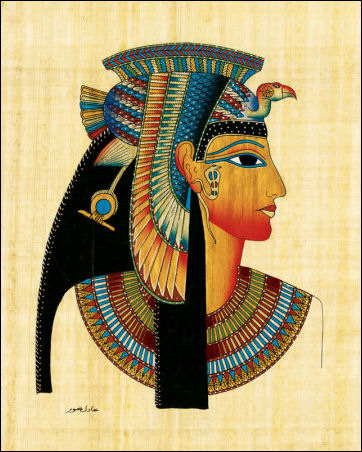 Cleopatra (69-30 B.C.) is one of the most famous women of all a time. A Greek Queen of Egypt, she played a major role in the extension of the Roman Empire and was a lover of Julius Caesar, the wife of Marc Antony and a victim of Augustus Caesar, the creator of the Roman Empire. Coin portraits and a bust reportedly made in her lifetime show her with a prominent nose and a large forehead. There were reports she had rotten teeth. But despite these flaws she is one of the world's most famous seductresses. [Source: Chip Brown, National Geographic, July 2011; Stacy Schiff, Smithsonian magazine, December 2010; Judith Thurman, The New Yorker, May 7, 2001 and November 15, 2010; Barbara Holland, Smithsonian, February 1997]
Cleopatra (69-30 B.C.) is one of the most famous women of all a time. A Greek Queen of Egypt, she played a major role in the extension of the Roman Empire and was a lover of Julius Caesar, the wife of Marc Antony and a victim of Augustus Caesar, the creator of the Roman Empire. Coin portraits and a bust reportedly made in her lifetime show her with a prominent nose and a large forehead. There were reports she had rotten teeth. But despite these flaws she is one of the world's most famous seductresses. [Source: Chip Brown, National Geographic, July 2011; Stacy Schiff, Smithsonian magazine, December 2010; Judith Thurman, The New Yorker, May 7, 2001 and November 15, 2010; Barbara Holland, Smithsonian, February 1997]
Stacy Schiff wrote in her book Cleopatra: A Biography, “Cleopatra VII ruled Egypt for 21 years a generation before the birth of Christ. She lost her kingdom once; regained it; nearly lost it again; amassed an empire; lost it all. A goddess as a child, a queen at 18, at the height of her power she controlled virtually the entire eastern Mediterranean coast, the last great kingdom of any Egyptian ruler. For a fleeting moment she held the fate of the Western world in her hands. She had a child with a married man, three more with another. She died at 39. Catastrophe reliably cements a reputation, and Cleopatra's end was sudden and sensational. [Source: Stacy Schiff, Smithsonian magazine, December 2010, Adapted from Cleopatra: A Biography, by Stacy Schiff."
"Fierce, voluptuous, passionate, tender, wicked, terrible, and full of poisonous and rapturous enchantment" is what Nathaniel Hawthorne wrote about Cleopatra in 1858. Shakespeare made her into a romantic heroine described her as a magnificent creature with a burning soul and deep love for Antony”..."Other women cloy / The appetites they feed, but she makes hungry / Where most she satisfies," Shakespear wrote..."George Bernard Shaw saw her as purring sex kitten. Closer to her own time, Propetius called her a "harlot queen of incest." Historians often mark her death as the end of both ancient Egypt and ancient Greece and the beginning of the Roman Empire.
Louisa Thomas wrote in Newsweek, “Cleopatra has always been a player in other people's dramas if in different roles: she can be a coquette or a feminist, a martyr or a villain, a goddess or a fallen woman, even blonde or black. Horace called her the fatale monstrum ---the fatal minster, Chaucer made her virtuous...In her own day, legions of Egyptians thought she was a reincarnation of the goddess Isis, while her nemesis, the Roman Octavian (Augustus), called her a whore. It is that description---Cleopatra as a vamp, a seductress whose machinations led to the downfall of Julius Caesar and Marc Antony---that dilates the countless depictions in art, literature, theater, film and not least, history books."
The critic Harold Bloom called Cleopatra the “world's first celebrity." Based on the number of books written about her (329 in 1999 in the Library of Congress collection), Cleopatra is the world's seventh most famous woman. Cleopatra was immortalized in plays by George Bernard Shaw and Shakespeare and played by Vivien Leigh and Elizabeth Taylor in Hollywood films.
Books and Sources on Cleopatra
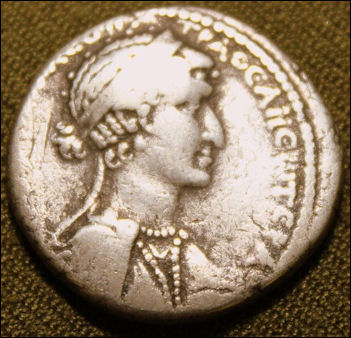
Cleopatra on a coinBooks: Cleopatra: the Last Queen of Egypt (Basic Books 2008) by Joyce Tyldesly, a lecturer in Egyptology at the University of Manchester in England; Cleopatra: Beyond the Myth By M Chauveau, translated by D. Lorton; Memoirs of Cleopatra by Margaret George Pan, a 1,000-page historical novel with vivid historical details; Cleopatra by Michael Grant (Phoenix Press (paperback), 2000 (originally published by Weidenfeld & Nicolson, Great Britain, 1972); Cleopatra: Histories, Dreams and Distortions by Lucy Hughes-Hallet (Harper & Row, 1990); Women & Society in Greek & Roman Egypt by Jane Rowlandson (Cambridge University Press, 1998); Antony and Cleopatra by Adrian Goldsworthy ((Yale, 2010); Cleopatra by Duane Roller (Oxford, 2010); Cleopatra: A Life by Stacy Schiff; (Little Brown, 2010).
Very little hard evidence about Cleopatra exists. Most of what know about her today is based on a biography written by Plutarch 200 years after her death. Early accounts of her life were given the anti-Cleopatra, pro-Roman slant promoted by Octavian. Other accounts of her life are mostly malicious, lack reliable sources, and were written centuries after her death. Careful historical analysis of her life and times has suggested that she was a highly competent ruler who skillfully navigated through a turbulent period of history surrounded by unstable neighbors. Politics more than sex seemed to be primary interest.
Judith Thurman wrote in the The New Yorker, “Among the writers who actually met Cleopatra, Cicero said of her “I detest the Queen” and ridiculed Rome for its “fribbling, fawning” attraction to for her ; Nicolaus of Damascus, her children's tutor, defected to her archrival Herod, and then to Octavian. Of first-century writers, Josephus, a Jewish historian writing for a Roman audience, based his account on Nicolaus’s; Plutarch, Antony's biographer, had access to some firsthand testimony, but admitted to cherry-picking. Suetonius and Appian, historians of the second century, and prolific Dio, of the third, have been flagged for complacency in their errors and biases. Theirs and many other ancient texts exist only in fragments. What survives of them, two thousand years after Cleopatra's death, is still the primary source for biographers. [Source: Judith Thurman, The New Yorker November 15, 2010]
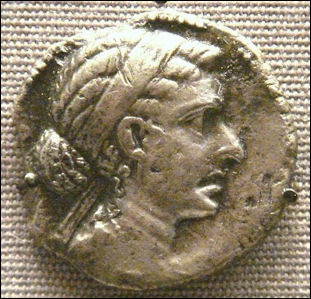
Cleopatra on a coinRoller's “Cleopatra," part of a series of brief lives on Women in Antiquity, Thurman wrote, gives a rich account of late Ptolemaic culture, and surveys the Queen's history in under two hundred pages. Roller is a professor emeritus of Greek and Latin at Ohio State University, so he had access to the ancient sources in their original languages, as well as to the scholarly literature in German and French. His voice is donnish and impartial, albeit a bit flat, like the daylight in his black-and-white photographs of modern Tarsus and Jericho, and his assertion that one really can't hope to know Cleopatra. This volume should appeal to readers who prefer an aerial view of the subject to the seething congestion of its ring roads. Goldsworthy is a distinguished biographer of Julius Caesar, and his somewhat mistitled entrant to the lists, “Antony and Cleopatra” (Yale; $35), is a four-hundred-page work of Roman military and political history. Whether we like it or not, biographers bring their experience as men or women to their task. Roller and Goldsworthy both seem determined to resist the temptations of a siren, as if she might corrupt their integrity.
Schiff won the Pulitzer Prize for her 1999 biography, Véra (Mrs. Vladimir Nabokov): Portrait of a Marriage . Angelina Jolie is slated to play Cleopatra in a forthcoming 3-D bio-pic, possibly to be directed by James Cameron based on Stacy Schiff's biography. On the biography, Thurman wrote, “Schiff relies on the same venerable Cleophobes, and exercises the same caution about them. Imaginative attunement with a subject, however, does not have to compromise a vigilant biographer's critical detachment, and Schiff's beautiful writing hums with that tension. This is her fourth ambitious life. It is an edifice of speculation and conjecture---like every “Cleopatra” ever written. But unlike nearly all of them it is a work of literature."
Allure and Mystery of Cleopatra

Cleopatra by
John William WaterhouseCleopatra has been obscured in what biographer Michael Grant called the "fog of fiction and vituperation which has surrounded her personality from her own lifetime onwards." Chip Brown wrote in National Geographic, “Despite her reputed powers of seduction, there is no reliable depiction of her face. What images do exist are based on unflattering silhouettes on coins. There is an unrevealing 20-foot-tall relief on a temple at Dendera, and museums display a few marble busts, most of which may not even be of Cleopatra. [Source: Chip Brown, National Geographic, July 2011]
Ancient historians praised her allure, not her looks. Certainly she possessed the ability to roil passions in two powerful Roman men: Julius Caesar, with whom she had one son; and Mark Antony, who would be her lover for more than a decade and the father of three more children. But her beauty, said Greek historian Plutarch, was not "the sort that would astound those who saw her; interaction with her was captivating, and her appearance, along with her persuasiveness in discussion and her character that accompanied every interchange, was stimulating. Pleasure also came with the tone of her voice, and her tongue was like a many-stringed instrument."
Stacy Schiff wrote in her book Cleopatra: A Biography, “She nonetheless survives as a wanton temptress, not the first time a genuinely powerful woman has been transmuted into a shamelessly seductive one. She elicited scorn and envy in equal and equally distorting measure; her story is constructed as much of male fear as of fantasy. Her power was immediately misrepresented because---for one man's historical purposes---she needed to have reduced another to abject slavery. Ultimately everyone from Michelangelo to Brecht got a crack at her. The Renaissance was obsessed with her, the Romantics even more so. [Source: Stacy Schiff, Smithsonian magazine, December 2010, Adapted from Cleopatra: A Biography, by Stacy Schiff."
Brown wrote: “The wealth of attention paid to Cleopatra by artists seems inversely proportional to the poverty of material generated about her by archaeologists. Alexandria and its environs attracted less attention than the more ancient sites along the Nile, such as the Pyramids at Giza or the monuments at Luxor. And no wonder: Earthquakes, tidal waves, rising seas, subsiding ground, civil conflicts, and the unsentimental recycling of building stones have destroyed the ancient quarter where for three centuries Cleopatra and her ancestors lived. Most of the glory that was ancient Alexandria now lies about 20 feet underwater...In the last hundred years about the only new addition to the archaeological record is what scholars believe is a fragment of Cleopatra's handwriting: a scrap of papyrus granting a tax exemption to a Roman citizen in Egypt in 33 B.C.
Cleopatra and Her Family
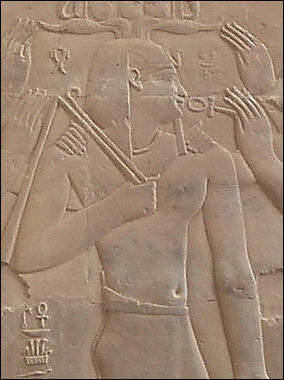
Ptolemy XIICleopatra was actually Cleopatra VII. She was not Egyptian and probably didn't even possess any Egyptian blood; she was the daughter of a Macedonian Greek king, Ptolemy XII, who ruled Egypt and was a descendant of one of Alexander the Great's generals. Cleopatra is Greek for “glory to her race." Some African-American groups claim that Cleopatra was a black woman. There is this little evidence to back this up. However Ptolemy XII had a mysterious concubine who could have been black and could have given birth to Cleopatra although it is very unlikely.
Ptolemy XII was as known the “Flute Player” because of his musical talent and his ability to charms the ladies---and the boys---with his playing and his taste for things he liked to stick in his mouth. Cleopatra's great-grand father was known as Ptolemy Physkon (“Potbelly”). He reportedly paraded around in flimsy robes to show off his flab (at that time regarded as sign of wealth).
Ptolemy XII's Egypt was still rich but it was becoming undermined by an unhappy local population, threatened by its rivals, and robbed by Roman moneylenders. Once while Ptolemy XII was in Rome his eldest daughter Tryphanena seized the throne. After she was assassinated the secondary daughter Berenike grabbed it. When Ptolemy returned he retook the throne with Cleopatra's help and Berenike was executed. Tryphanena and Berenike were Cleopatra's elder sisters or half sisters.
Cleopatra's Early Life
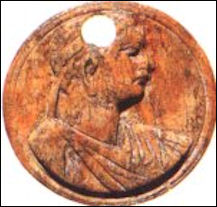
Ptolemy XIVCleopatra VI was born in 69 B.C. She was the second or third of five or six children of Ptolemy XII and his wife and sister Cleopatra V. Her grandmother may have been a concubine. Er mother was her father's full sister or perhaps an Egyptian of the local aristocracy. It is assumed she was educated as Ptolemaic princess in her time with instructions im literature, mathematics, philosophy, music, medicine and the martial arts.
In 51 B.C., after her father died, Cleopatra married her 10-year-old brother, Ptolemy XIII and the two of them became co-rulers of Egypt. Cleopatra was only 17. Cleopatra's marriage to her Ptolemy XIII was most likely unconsummated. After they took over the throne the Nile didn't flood and their was a famine. A eunuch named Pothinus was appointed regent for young Ptolemy and Cleopatra was driven out of Alexandria, resulting in a civil war.
Cleopatra's seized the Ptolemic throne with the help of Julius Caesar. Ptolemy XIII reportedly drowned in the Nile with a full suit of armor on. The circumstances behind the death were unclear. Caesar then arranged the marriage of Cleopatra and her younger brother Ptolemy XIV, whom was only 12 at the time and Cleopatra was able to dominate him
Cleopatra's Looks and Her Reputation as a Seducer
 Plutarch wrote: "Her beauty was not incomparable” but “the attraction of her conversation...was something bewitching...The persuasiveness of her discourse and her character...had something stimulating about it. It was a pleasure merely to hear her voice, with which, like an instrument of many strings, she could pass from one language to the next...Plato admits four sorts of flattery but she has a thousand." Another historian described her countenance as "alive rather than beautiful."
Plutarch wrote: "Her beauty was not incomparable” but “the attraction of her conversation...was something bewitching...The persuasiveness of her discourse and her character...had something stimulating about it. It was a pleasure merely to hear her voice, with which, like an instrument of many strings, she could pass from one language to the next...Plato admits four sorts of flattery but she has a thousand." Another historian described her countenance as "alive rather than beautiful."
The 2nd century Greek historian said that Cleopatra seduced men because she was "brilliant to look upon...with the power to subjugate everyone." She would later become "a woman of insatiable sexuality and insatiable avarice" (Dio), "the whore of the eastern kings" (Boccaccio). She was a carnal sinner for Dante, for Dryden a poster child for unlawful love. A first-century A.D. Roman would falsely assert that "ancient writers repeatedly speak of Cleopatra's insatiable libido." Florence Nightingale referred to her as "that disgusting Cleopatra." Offering Claudette Colbert the title role in the 1934 movie, Cecile B. DeMille is said to have asked, "How would you like to be the wickedest woman in history?" [Source: Stacy Schiff, Smithsonian magazine, December 2010, Adapted from Cleopatra: A Biography, by Stacy Schiff."
Images close to her time contradict the notion that she a great beauty. The pictures of Cleopatra depicted on Roman coins shows a woman with a large hooked Semitic nose, sharp chin, boney face, narrow forehead and large eyes. Stacy Schiff wrote in her book Cleopatra: A Biography, “If the name is indelible, the image is blurry. She may be one of the most recognizable figures in history, but we have little idea what Cleopatra actually looked like. Only her coin portraits---issued in her lifetime, and which she likely approved---can be accepted as authentic."
Cleopatra's Charms, Sex Life and Intelligence
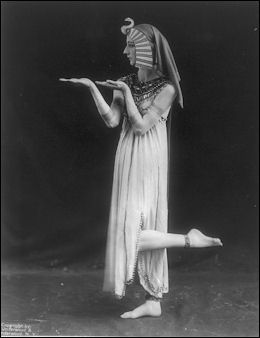 Cleopatra, it is said, liked to bathe in freshly-squeezed ass milk or goat milk. She wrote her own book on cosmetics. One concoctions was made with burnt mice. She also reportedly used a perfume made from rose oil and violets on her hands and anointed her feet with an oil made with honey, cinnamon, iris, hyacinth and orange blossoms. Incense burners surrounded her throne.
Cleopatra, it is said, liked to bathe in freshly-squeezed ass milk or goat milk. She wrote her own book on cosmetics. One concoctions was made with burnt mice. She also reportedly used a perfume made from rose oil and violets on her hands and anointed her feet with an oil made with honey, cinnamon, iris, hyacinth and orange blossoms. Incense burners surrounded her throne.
Cleopatra could speak seven languages, according to Plutarch, and had a keen interests in science and literature. Cicero met her at Caesar's house. Although he loathed her and regarded her as arrogant he admitted she was intelligent and was involved in "things that had to do with learning."
Cleopatra is said to have wrote treatises on alchemy, weights and measures and gynecology. The 10th century Arab historian Al-Masudi wrote many centuries after her death, she was "a princess well versed in the sciences, disposed to the study of philosophy and counted scholars among her intimate friends. She was the author of works on medicine , charms, and other divisions of the natural sciences. The books bear her name and were well known among men conversant with art and medicine."
Cleopatra reportedly had her first lover at twelve and built a temple where she kept male lovers drugged with performance boosters. She also purported had 100 lover in a single night, slept with her slaves, and heavily taxed or killed some men after the love-making was over. She learned many tricks it is said from courtesan at an Alexandria bordello. The Romans, who wanted to portray Cleopatra in the worst light possible light, were the source of many of these stories. In reality it is thought she spent much of her time sleeping alone and was busy managing her kingdom to indulge in too much debauchery. Her reputation a sex freak endured through the years. Obscene caricatures from the A.D. 1st century show a Cleopatra-like figure on a barge copulating with a crocodile. In famous 18th century European paintings she lies naked in a voluptuous pose on lion skins with an asp biting into her swelling bosom.
Egypt and Rome at the Time Cleopatra Became Leader

Cleopatra from the Ruins of DenderaStacy Schiff wrote in her book Cleopatra: A Biography, Cleopatra “and her 10-year-old brother assumed control of a country with a weighty past and a wobbly future. The pyramids, to which Cleopatra almost certainly introduced Julius Caesar, already sported graffiti. The Sphinx had undergone a major restoration---more than 1,000 years earlier. And the glory of the once-great Ptolemaic empire had dimmed. [Source: Stacy Schiff, Smithsonian magazine, December 2010, Adapted from Cleopatra: A Biography, by Stacy Schiff."
Cleopatra took the throne of Egypt at a time when Egypt was the richest place in the Middle East. But at the same time the Ptolemaic empire was crumbling. Chip Brown wrote in National Geographic, The lands of Cyprus, Cyrene (eastern Libya), and parts of Syria had been lost; Roman troops were soon to be garrisoned in Alexandria itself. Still, despite drought and famine and the eventual outbreak of civil war, Alexandria was a glittering city compared to provincial Rome. Cleopatra was intent on reviving her empire, not by thwarting the growing power of the Romans but by making herself useful to them, supplying them with ships and grain, and sealing her alliance with the Roman general Julius Caesar with a son, Caesarion. [Source: Chip Brown, National Geographic, July 2011]
Schiff wrote: “Over the course of Cleopatra's childhood Rome extended its rule nearly to Egypt's borders. The implications for the last great kingdom in that sphere of influence were clear. Its ruler had no choice but to court the most powerful Roman of the day?a bewildering assignment in the late Republic, wracked as it was by civil wars...Cleopatra's father had thrown in his lot with Pompey the Great. Good fortune seemed eternally to shine on that brilliant Roman general, at least until Julius Caesar dealt him a crushing defeat in central Greece. Pompey fled to Egypt, where in 48 B.C. he was stabbed and decapitated. Twenty-one-year-old Cleopatra was at the time a fugitive in the Sinai---on the losing side of a civil war against her brother and at the mercy of his troops and advisers. Quickly she managed to ingratiate herself with the new master of the Roman world.
Meanwhile the Roman civil wars raged on, as tempers flared between Mark Antony, Caesar's protégé, and Octavian, Caesar's adopted son. Repeatedly the two men divided the Roman world between them. Cleopatra ultimately allied herself with Antony, with whom she had three children; together the two appeared to lay out plans for an eastern Roman empire. Antony and Octavian's fragile peace came to an end in 31 B.C., when Octavian declared war---on Cleopatra. He knew Antony would not abandon the Egyptian queen. He knew too that a foreign menace would rouse a Roman public that had long lost its taste for civil war. The two sides ultimately faced off at Actium, a battle less impressive as a military engagement than for its political ramifications. Octavian prevailed. Cleopatra and Antony retreated to Alexandria. After prolonged negotiation, Antony's troops defected to Octavian.
Julius Caesar Helps Cleopatra Seize the Egyptian Throne
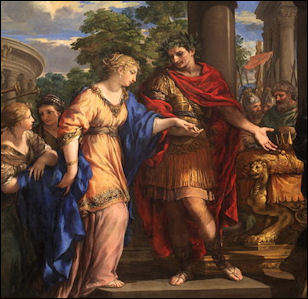
Caesar giving Cleopatra
the Throne of EgyptJulius Caesar arrived in Alexandria days after Pompey's murder. He barricaded himself in the Ptolemies' palace, the home from which Cleopatra had been exiled. From the desert she engineered a clandestine return, skirting enemy lines and Roman barricades, arriving after dark inside a sturdy sack. Over the succeeding months she stood at Caesar's side---pregnant with his child---while he battled her brother's troops. With their defeat, Caesar restored her to the throne.
Judith Thurman wrote in The New Yorker the morning after Cleopatra finagled her way into Caesar's stronghold “her brother dashed into the streets and nearly persuaded a mob to rise against the usurpers.Caesar's Praetorians dragged him back inside, but his handlers rallied their forces...In the ensuing wars against Caesar and Cleopatra, which the world's greatest general nearly lost (until reinforcements arrived, he was severely shorthanded), Ptolemy drowned. The victors celebrated with a leisurely Nile cruise, a visit to the pyramids, and some whistlestopping in the heartland. The public honeymoon demonstrated an inspired gift for mixing business with pleasures, and both with stagecraft." [Source: Judith Thurman, The New Yorker November 15, 2010]
Giving birth to Caesar's son, Thurman wrote, “consolidated her bands with his father, and with her own people and their priests, who rejoiced at a male heir. With a son as her symbolic co-regent and caesar as her protector, Cleopatra had no need to remarry. She henceforth governed alone---uniquely so among female monarchs of her period. Her autonomy depended on the fickle good will of Rome, and her exchange of favors with two Roman leaders.
Cleopatra as a Leader
 Cleopatra ascended to the throne in 51 B.C. at age 18. She ruled for 21 years. In that time she survived revolts and exile, showed superb diplomatic skills and used divine mandate and patronage to keep a firm grip on power. She shrewdly formed an alliance with the priesthood, who promoted her cult as mother goddess, and used delaying tactics on important decisions to avoid making mistakes. The simple fact that she lasted as long as did at a time of great upheaval and change is testimony enough of her ability as a leader.
Cleopatra ascended to the throne in 51 B.C. at age 18. She ruled for 21 years. In that time she survived revolts and exile, showed superb diplomatic skills and used divine mandate and patronage to keep a firm grip on power. She shrewdly formed an alliance with the priesthood, who promoted her cult as mother goddess, and used delaying tactics on important decisions to avoid making mistakes. The simple fact that she lasted as long as did at a time of great upheaval and change is testimony enough of her ability as a leader.
Stacy Schiff wrote in her book Cleopatra: A Biography, “A capable, clear-eyed sovereign, she knew how to build a fleet, suppress an insurrection, control a currency. One of Mark Antony's most trusted generals vouched for her political acumen. Even at a time when female rulers were no rarity, Cleopatra stood out, the sole woman of her world to rule alone. She was incomparably richer than anyone else in the Mediterranean. And she enjoyed greater prestige than every other woman of her time, as an excitable rival king was reminded when he called for her assassination during her stay at his court. (The king's advisers demurred. In light of her stature, they reminded Herod, it could not be done.) Cleopatra descended from a long line of murderers and upheld the family tradition, but was for her time and place remarkably well behaved. [Source: Stacy Schiff, Smithsonian magazine, December 2010, Adapted from Cleopatra: A Biography, by Stacy Schiff."
“Her tenure alone speaks to her guile. She knew she could be removed at any time by Rome, deposed by her subjects, undermined by her advisers---or stabbed, poisoned and dismembered by her own family. In possession of a first-rate education, she played to two constituencies: the Greek elite, who initially viewed her with disfavor, and the native Egyptians, to whom she was a divinity and a pharaoh. She had her hands full. Not only did she command an army and navy, negotiate with foreign powers and preside over temples, she also dispensed justice and regulated an economy. Like Isis, one of the most popular deities of the day, Cleopatra was seen as the beneficent guardian of her subjects. Her reign is notable for the absence of revolts in the Egyptian countryside, quieter than it had been for a century and a half." [Ibid]
A sample of Cleopatra's handwriting exists on two fragments of papyrus featured in an exhibit on Cleopatra at Philadelphia's Franklin Museum in 2010. The documents with the Greek inscription “make it happen” refers to a tax break for a friend of Mark Antony. The documents and 150 other artifacts were found during an intensive search for her tomb in the Egyptian town of Taposiris Magnas and the submerged ancient cities of Heracleion and Canopus, where earthquakes and tidal waves destroyed Cleopatra's palace. Also on display at the exhibit entitled “Cleopatra---the Search for the Last Queen of Egypt--- were gold necklaces, bracelets, a sculpture of the son of Cleopatra and Julius Caesar and sling shot bullets that may have been used by Roman armies to claim Egypt after Cleopatra's death in 30 B.C.
Cleopatra and Ancient Egyptian Traditions
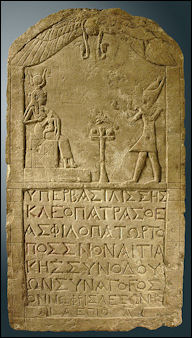
Cleopatra as Isis “Lest her subjects resent her Roman overtures," Brown wrote, “Cleopatra embraced Egypt's traditions. She is said to have been the first Ptolemaic pharaoh to bother to learn the Egyptian language. While it was politic for foreign overlords to adopt local deities and appease the powerful religious class, the Ptolemies were genuinely intrigued by the Egyptian idea of an afterlife. Out of that fascination emerged a hybrid Greek and Egyptian religion that found its ultimate expression in the cult of Serapis---a Greek gloss on the Egyptian legend of Osiris and Isis." [Ibid]
“One of the foundational myths of Egyptian religion, the legend tells how Osiris, murdered by his brother Seth, was chopped into pieces and scattered all over Egypt. With power gained by tricking the sun god, Re, into revealing his secret name, Isis, wife and sister of Osiris, was able to resurrect her brother-husband long enough to conceive a son, Horus, who eventually avenged his father's death by slaughtering uncle Seth. By Cleopatra's time a cult around the goddess Isis had been spreading across the Mediterranean for hundreds of years. To fortify her position, and like other queens before her, Cleopatra sought to link her identity with the great Isis (and Mark Antony's with Osiris), and to be venerated as a goddess. She had herself depicted in portraits and statues as the universal mother divinity...She appeared in the holy dress of Isis at a festival staged in Alexandria to celebrate Antony's victory over Armenia in 34 B.C., just four years before her suicide and the end of the Egyptian empire." [Ibid]
Image Sources: Wikimedia Commons, The Louvre, The British Museum
Text Sources: New York Times, Washington Post, Los Angeles Times, Times of London, Yomiuri Shimbun, The Guardian, National Geographic, The New Yorker, Time, Newsweek, Reuters, AP, Lonely Planet Guides, Compton's Encyclopedia and various books and other publications. Most of the information about Greco-Roman science, geography, medicine, time, sculpture and drama was taken from "The Discoverers" [∞] and "The Creators" [μ]" by Daniel Boorstin. Most of the information about Greek everyday life was taken from a book entitled "Greek and Roman Life" by Ian Jenkins from the British Museum [||].
No comments:
Post a Comment